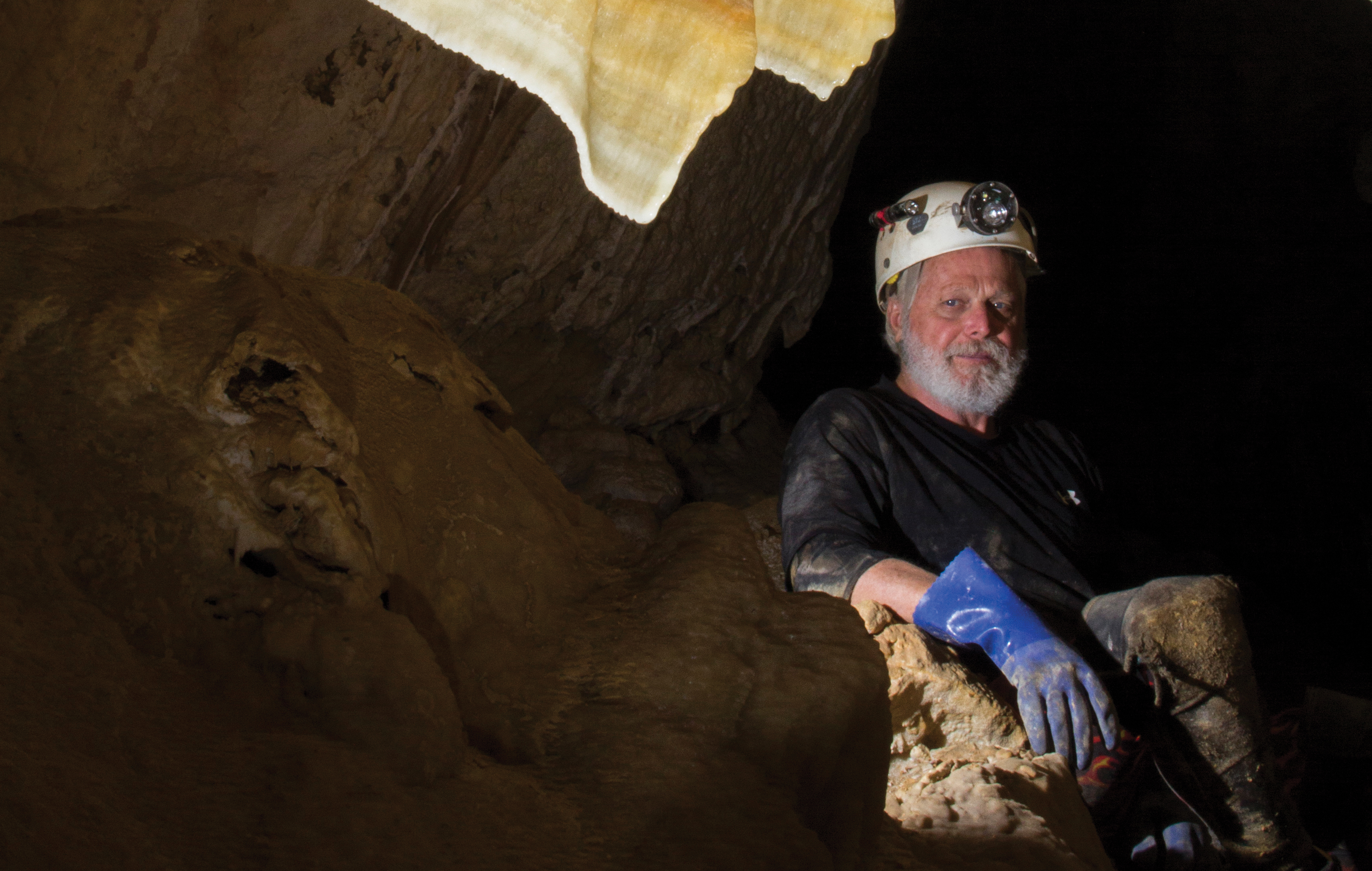Career of the Month
Speleologist Bill Steele
The Science Teacher—February 2020 (Volume 87, Issue 6)
By Luba Vangelova

Bill Steele in Harrison’s Cave, Barbados. Photo courtesy of Bennett Lee.
Speleologists study caves and other features of karst topographies, which are areas of soluble rock that have been excavated by underground water systems. Speleology is often an unpaid, lifelong passion, but there are also job opportunities for cave experts to work in academia, in the mining sector, as entrepreneurs (designing and selling caving equipment), and at different levels of government (to manage caves or interpret them to visitors at public parks). Cave experts are also sometimes hired to work on various groundwater-related issues. Bill Steele is an independent speleologist based in Irving, Texas.
Work overview
I explore caves on my own and also assist researchers. I’m currently focusing on leading expeditions to the Huautla cave system in Mexico. It has rivers, fossils, archaeological evidence of ancient cave use by humans, and other elements that appeal to all of the scientific disciplines of speleology. Geologists have gone there to study the exposed limestone levels and map the cave beds. I’ve helped them find fossils in the walls, using special instruments they may not have, and I’ve recorded their data. Biologists have captured bats in the cave and put bands on them to monitor their migration patterns. I’ve helped them with lighting and photography, which is its own art form in caves. I’ve also worked with paleontologists, by finding bones of extinct animals such as giant ground sloths and huge Pleistocene sheep, notifying the researchers who would want to study them, and then assisting the researchers, including in some cases helping them publish papers in speleological journals. They’re the experts in their fields, and I’m the expert on the environment we’re working in, which is very different from other environments.
Career highlights
The cave is home to species that have evolved separately from all other species. It’s a totally dark environment, so they’ve lost their eyesight, but their sense of touch is incredibly acute.
I’ve been involved in the discovery of 48 previously unknown living species, such as spiders, millipedes, and scorpions that are unique to this cave. My coolest discovery was in 2018, when I noticed a scorpion while taking a brief break inside the cave. I collected it in ethanol alcohol and sent it to a researcher, who then sent graduate students to work with me to collect more specimens. A species of tarantula that was discovered there by a graduate student was also named after me.
Career path
My first memory involved entering a cave on a family vacation as a four-year-old. I liked it so much, because it felt like I was in a different world that felt cool and dark. As a 13-year-old Boy Scout, I went into a cave that no one had been in before, and I’ve been exploring and studying caves ever since. Growing up in Ohio, I occasionally had opportunities to go to Kentucky to explore Mammoth Cave. At 400 miles long, it’s the world’s longest cave. I met top scientists there, and got to know what they were looking for.
I started as a geology major in college, but after a year, I decided it was not really for me. My interest was not in finding oil, natural gas, or precious metals, which is where most of the jobs are in this field. Also, I was more of an organizer and people person, who appreciates science and wants to promote it. So I ended up getting a degree in nonprofit management instead.
After graduation, a partner and I ran a guide company for a year, taking people to caves they wouldn’t be able to go to on their own, because of the technical expertise, ropes, and other equipment required. But I found it nerve-wracking—we were hired by some people who had no business being in such caves, and we had to watch them closely to make sure they remained safe. So I got a job at the Boy Scouts of America, where I worked my way up to be a national-level director. I had a good career and still managed to make a difference in speleology.
While at the Boy Scouts, I introduced an Exploration merit badge, which can be earned in any type of exploration, including speleology. I also reintroduced the World Explorers program, and each summer led four selected Eagle Scouts to Mammoth Cave. I spent almost all my weekends and vacations exploring caves in the United States and in other countries, such as Mexico, Cuba and China. Since retiring five years ago, I’ve been able to do even more caving. I can’t get enough of it.
Knowledge, skills, and training needed
Read about caving and find other people who are interested in the subject. If you live near a tourist cave, you should be able to find a local caving club. Visit caves with people who know what they’re doing and have the right gear, which can include specialized climbing or diving equipment. There are a lot of skills to learn, such as knowing how to find your way out of a cave.
Geology classes are useful. If you understand why caves exist in certain landscapes, it helps you understand their patterns. By understanding the patterns, you can map a cave in your head and know where to look for entrances or additional passageways.
Advice for students
Follow your heart, study subjects that interest you, and see where it leads you. After your freshman year of college, or even right after high school, try to get an internship at Carlsbad Caverns, a state park with a cave, or a tourist cave. There are also scholarships available and summer camps specializing in various science disciplines.
Bonus Points
Steele’s education: BS in nonprofit management, Indiana University.
On the web:
https://caves.org/youth/National_BSA_youth_caving_presentation.pdf
Related careers: geologist, biologist, paleontologist, archaeologist, anthropologist, tour guide.


